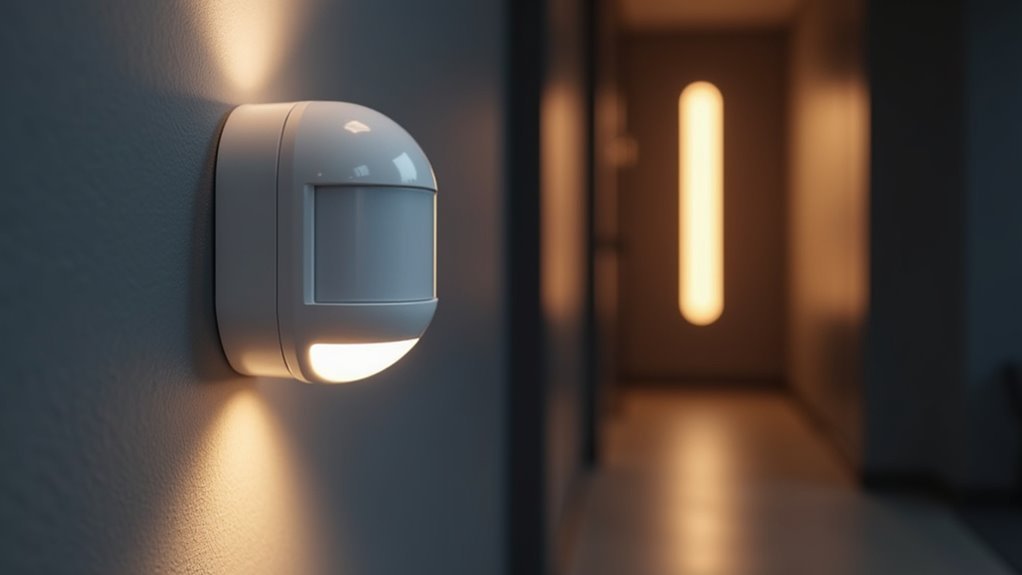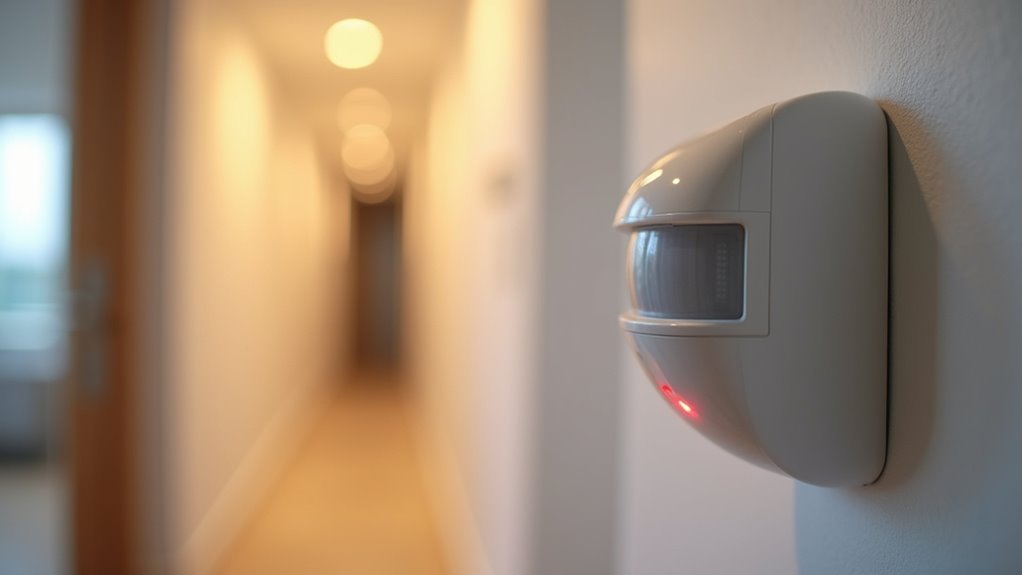You’ve probably walked into a room and wished the lights would automatically turn on, or wondered if someone’s lurking around your property when you’re away. Motion sensors can transform your home into a smarter, more secure space that responds to your presence while keeping unwanted visitors at bay. These devices aren’t just about convenience—they’re strategic investments that’ll impact your safety, energy bills, and daily routines in ways you might not expect.
What Are Motion Sensors and How Do They Detect Movement

Whether you’re looking to enhance your home security or simply automate your lighting, motion sensors serve as the electronic eyes that monitor your living spaces by detecting movement within designated areas.
These electronic devices work by sensing changes in infrared radiation, heat, or sound patterns around them.
Motion sensors function as sophisticated detection systems that monitor environmental changes to identify movement and trigger automated responses.
You’ll encounter two main types: Passive Infrared (PIR) sensors and Ultrasonic sensors.
PIR sensors detect movement by identifying heat signatures from living beings, making them excellent for spotting intruders or family members. They’re energy-efficient and highly effective at detecting human body warmth.
Ultrasonic sensors use high-frequency sound waves to identify movement but can trigger false alarms from minor disruptions.
Both types enable your security system to activate alarms, send alerts, or trigger lighting automatically.
Types of Motion Sensors Available for Home Installation
When selecting motion sensors for your home, you’ll discover several distinct technologies that cater to different security and automation needs.
PIR sensors detect heat from living beings, making them energy-efficient options that recognize human movement effectively.
Ultrasonic sensors use high-frequency sound waves to cover areas where PIR technology might struggle.
Microwave sensors emit microwaves and measure reflections, providing wider detection ranges than PIR alternatives.
Dual technology sensors combine PIR with ultrasonic or microwave capabilities, reducing false alarms by distinguishing between humans and non-threatening movements.
Smart cameras with motion detection algorithms enhance your home security system by analyzing video feeds to differentiate between people and objects.
Each type of motion sensor offers unique advantages for detecting movement throughout your property.
Enhanced Security Through Automated Intrusion Detection

Beyond basic movement detection, modern motion sensors transform your home into an intelligent security fortress that actively monitors for potential threats.
These sophisticated devices excel at motion detection by distinguishing between human movement and harmless objects like pets or swaying branches, dramatically reducing false alarms that plague traditional systems.
When sensors detect genuine suspicious activity, they instantly trigger alerts to your smartphone and security network, creating real-time awareness of potential intrusions.
This immediate notification system means you’ll know about threats whether you’re upstairs sleeping or miles away at work.
Your smart home security becomes even more robust when motion sensors integrate with other protective measures like door sensors and cameras, establishing multiple detection layers that criminals struggle to bypass.
Energy Savings With Smart Lighting Control
You’ll greatly reduce your electricity bills when motion sensors automatically manage your lighting systems throughout your home.
These smart devices guarantee lights only activate when you’re actually in a room, eliminating the waste from forgotten switches and unnecessary illumination.
You can expect to cut your annual lighting costs by up to 30% while enjoying the convenience of never having to worry about lights left on again.
Automated Light Management
Since motion sensors can automatically control your home’s lighting based on occupancy, you’ll dramatically reduce energy waste and see significant savings on your electricity bills.
These smart devices eliminate the guesswork of whether lights remain on in unoccupied rooms.
Motion sensors enhance your home’s energy efficiency through three key mechanisms:
- Automatic shut-off when no movement is detected in rooms
- Occupancy-based activation that turns lights on only when needed
- Seamless integration with other smart home systems for thorough energy management
Your automated lighting functions work around the clock, ensuring electricity consumption matches actual room usage.
Studies demonstrate that motion sensors can reduce energy costs by up to 30%, making them a valuable investment for energy-conscious homeowners seeking both convenience and substantial utility savings.
Reduced Electricity Bills
When motion sensors take control of your lighting system, your electricity bills drop substantially through precise energy management. You’ll reduce electricity consumption by up to 30% compared to traditional lighting systems through occupancy-based control that activates lights only when rooms are occupied.
| Feature | Traditional Lighting | Motion Sensor Lighting |
|---|---|---|
| Energy Waste | Lights left on unnecessarily | Automatic shutoff prevents waste |
| Control Method | Manual switching | Occupancy-based activation |
| Savings Potential | 0% optimization | Up to 30% cost reduction |
Programming your sensors for specific time periods maximizes energy efficiency by ensuring lights operate only when needed. You’ll eliminate uncertainty about whether lights are switched off when leaving rooms, preventing continuous energy waste. This integration supports sustainable living while delivering significant long-term savings on energy costs.
Convenience and Home Automation Benefits

Although motion sensors excel at security applications, their convenience and automation capabilities truly transform how you interact with your home daily.
These smart devices seamlessly integrate into home automation systems, eliminating manual tasks and creating effortless living experiences.
Motion sensors deliver convenience through intelligent automation:
- Automated lighting and climate control – Lights turn on when you enter rooms, and heating systems adjust based on occupancy patterns.
- Pet-friendly detection – Advanced sensors differentiate between human and pet movements, preventing false triggers while maintaining functionality.
- Programmable schedules – You can set specific time periods for automation, ensuring systems operate efficiently during peak usage hours.
This integration creates a cohesive smart home environment where multiple systems work together, reducing your need for constant manual intervention while optimizing comfort throughout your daily routines.
Choosing the Right Motion Sensor Technology for Your Needs
Which motion sensor technology best fits your specific home security and automation needs?
You’ll want to take into account PIR sensors for indoor spaces since they’re ideal for detecting heat from moving bodies. For larger areas requiring subtle movement tracking, ultrasonic sensors work better.
Microwave sensors offer wider coverage and can penetrate obstacles, making them perfect for outdoor applications where you need to detect intruders effectively, though they may trigger false alarms from non-living objects.
Dual technology motion detectors combine PIR with ultrasonic or microwave features, providing enhanced accuracy by reducing false alarms through multi-modal detection.
When selecting sensors for smart devices integration, evaluate each sensor’s range and detection angle. Verify outdoor sensors are weatherproof with higher sensitivity for peak intruder detection at entry points.
Strategic Placement for Optimal Coverage and Protection
You’ll get the most protection from your motion sensors when you position them strategically throughout your home.
Focus first on covering all entry points like doors and windows, since these are where intruders typically gain access.
Next, establish indoor motion zones in key areas like hallways, staircases, and rooms containing valuables to create thorough coverage of movement patterns.
Entry Points Coverage
When protecting your home with motion sensors, focusing on entry points creates the most effective first line of defense.
These primary access points—doors and windows—represent where intruders typically attempt unauthorized entry, making motion detection at these locations absolutely critical for thorough security.
You’ll want to prioritize these key entry points:
- Main doors and windows – Install sensors directly at these primary access points for immediate alerts.
- Sliding glass doors and garage doors – These vulnerable areas are often overlooked in standard security setups.
- Secondary entrances – Back doors, basement entries, and side entrances require equal attention.
Strategic entry point coverage guarantees you’re alerted the moment someone attempts to breach your home’s perimeter, giving you precious time to respond appropriately.
Indoor Motion Zones
Beyond securing entry points, creating extensive indoor motion zones transforms your home’s interior into a layered security network that catches intruders who’ve already breached your perimeter.
Position motion sensors strategically in high-traffic areas like hallways and staircases where movement is unavoidable. Corner placements maximize coverage while minimizing blind spots, ensuring thorough monitoring throughout your spaces.
Focus on protecting rooms containing valuable items, such as home offices and bedrooms, for immediate alerts of unusual activity.
However, avoid placing sensors near pet areas to prevent false alarms from your furry friends roaming around. This strategic approach to indoor motion zones creates multiple detection points that’ll catch unauthorized movement, making your home security system far more effective than relying solely on entry point monitoring.
Tools and Equipment Needed for DIY Installation
Installing motion sensors yourself requires just a handful of common tools that most homeowners already have in their toolkit.
You’ll need basic equipment to guarantee proper installation and functionality of your motion sensors.
Essential tools for your DIY project include:
- Basic hand tools – A screwdriver, drill, and level for secure mounting and proper alignment
- Measuring equipment – Measuring tape to determine ideal height and placement for detection coverage, plus a stud finder for locating sturdy anchor points
- Power supplies – Correct batteries for wireless sensors and optionally a smartphone or computer for configuration
Having these tools ready before starting your installation guarantees you can mount your motion sensors correctly and integrate them seamlessly into your existing smart home system.
Step-by-Step Installation Process for Indoor Sensors
With your tools gathered and ready, you can start the actual installation of your indoor motion sensors. First, select an ideal location high on a wall or ceiling to maximize detection range. Avoid areas near heat sources, vents, or direct sunlight that could trigger false alarms through temperature fluctuations.
Remove the adhesive backing or use screws to securely attach the sensor, ensuring it’s level and stable. Adjust the sensor’s angle to enhance its field of vision toward high-traffic areas like doorways and hallways where movement detection is most critical.
After installing motion sensors, test their functionality by walking within the detection range. Confirm they activate correctly and adjust sensitivity settings as needed to minimize false alarms while maintaining effective coverage.
Outdoor Motion Sensor Setup and Weatherproofing
While indoor sensors operate in controlled environments, outdoor motion sensors face harsh weather conditions that demand careful selection and strategic placement.
You’ll need weather resistance with an IP65 rating minimum to protect against rain and dust. Position your outdoor sensors 8-10 feet above ground to prevent tampering and reduce false alarms from small animals.
Follow these essential steps for ideal setup:
- Choose adjustable sensitivity settings to accommodate environmental changes like wind or moving branches
- Install in well-lit areas where sensors can integrate with exterior lighting systems
- Establish regular maintenance schedules to clear debris and moisture that impair performance
Proper weatherproofing guarantees your motion sensors deliver reliable detection while withstanding outdoor elements year-round.
Connecting Motion Sensors to Your Smart Home System
Once you’ve established your outdoor motion sensor network, integration with your smart home system transforms these devices from simple detectors into powerful automation hubs.
Motion sensors seamlessly connect with popular platforms like Amazon Alexa, Google Assistant, and Apple HomeKit, enabling voice control and centralized management.
You can create customized automation routines where lights automatically turn on when entering rooms, thermostats adjust based on occupancy, or security systems activate cameras upon detecting outdoor movement.
Real-time notifications reach your smartphone instantly, keeping you informed of any detected activity.
This integration allows motion sensors to trigger multiple simultaneous actions, creating a cohesive smart home ecosystem that responds intelligently to your presence and movement patterns throughout your property.
Calibrating Sensitivity Settings and Detection Zones
After connecting your motion sensors to your smart home system, proper calibration becomes essential for ideal performance.
Calibrating sensitivity settings helps minimize false alarms by adjusting movement thresholds, ensuring sensors respond only to significant motions rather than minor disturbances.
Properly calibrated motion sensors distinguish between meaningful activity and everyday disturbances, dramatically reducing unnecessary alerts while maintaining robust security coverage.
Customizing detection zones allows you to focus monitoring on specific areas while excluding high-traffic spaces where pets roam. You can also define detection ranges based on room size and layout requirements.
Follow these calibration steps:
- Adjust sensitivity levels to balance detection accuracy with false alarm prevention
- Configure detection zones to exclude pet pathways and focus on entry points
- Review settings seasonally to account for furniture changes and environmental factors
Combining different sensor types like PIR and ultrasonic improves reliability, as each can be tailored for specific detection needs.
Preventing False Alarms and Troubleshooting Common Issues
Even with careful calibration, motion sensors can still generate unwanted alerts that disrupt your daily routine. To prevent false alarms, choose sensors with pet immunity features that distinguish between small animals and human movement.
Position your devices away from air vents, heaters, and windows where temperature fluctuations create false triggers. Secure lightweight objects like curtains or decorations that might sway and activate sensors unexpectedly.
Avoid installing motion sensors in high-traffic areas where constant movement occurs. When your motion sensor detects unwanted activity, adjust the sensitivity settings to match your specific environment.
Regular maintenance checks guarantee peak performance. If problems persist, verify proper mounting height and angle, clean the sensor lens, and check for interference from nearby electronics that might affect detection accuracy.
Maintenance Tips for Long-Term Sensor Performance
Keeping your motion sensors running smoothly requires consistent upkeep that’ll extend their lifespan and reliability.
You should replace batteries in wireless sensors at least once yearly or whenever low-battery alerts appear to prevent unexpected shutdowns.
Additionally, you’ll need to clean sensor lenses regularly with a soft cloth to remove dust and debris that can interfere with detection accuracy.
Regular Battery Replacement
While motion sensors are designed to operate reliably for extended periods, their battery-powered nature means you’ll need to establish a consistent replacement schedule to maintain peak performance.
Regular battery replacement guarantees your smart motion sensors and home security cameras continue providing reliable protection without unexpected downtime.
To maintain ideal functionality, follow these essential maintenance practices:
- Replace batteries every six months using high-quality electronic device batteries rather than inferior alternatives that compromise detection capabilities.
- Set up scheduled reminders to track replacement dates and guarantee proactive maintenance before batteries fail.
- Test sensors monthly after replacements to confirm they’re responding appropriately to movement.
Consider rechargeable batteries for eco-friendly convenience while reducing waste.
This systematic approach keeps your security system functioning consistently and prevents the frustration of discovering dead sensors when you need protection most.
Clean Sensor Lenses
Dust accumulation and environmental debris can greatly compromise your motion sensor’s detection accuracy over time.
You’ll need to clean sensor lenses regularly using a soft, lint-free cloth to maintain peak performance. Mix mild detergent with water for thorough cleaning, but avoid harsh chemicals that could damage the sensor’s delicate surface.
During maintenance, inspect the housing for wear or damage that might affect functionality. Replace sensors showing signs of deterioration immediately.
Keep the surrounding area clear of obstructions like cobwebs, vegetation, or other debris that can block the lens and reduce detection effectiveness.
Schedule routine maintenance checks every few months to guarantee all motion sensors operate properly.
This proactive approach helps you identify potential issues before they compromise your home security system’s reliability.
Frequently Asked Questions
Why Do People Have Motion Sensors in Their House?
You install motion sensors because they’ll alert you to intruders, automatically control lights and heating to save energy, reduce false alarms, and enhance your smart home’s convenience and security.
What Are the Benefits of a Motion Sensor?
You’ll enjoy enhanced security with instant alerts, reduced energy bills through automatic shutoffs, fewer false alarms with advanced detection, convenient home automation, and extensive protection when integrated with existing systems.
Do I Need Motion Sensors in My House?
You don’t necessarily need motion sensors, but they’ll greatly improve your home’s security, reduce energy costs, and increase convenience through automation. They’re especially valuable if you prioritize safety and efficiency.
Why Do We Need Motion Detection?
You need motion detection because it’ll enhance your home’s security by alerting you to potential intrusions, improve energy efficiency by automating lights and heating, and provide convenient smart home automation.





Leave a Reply